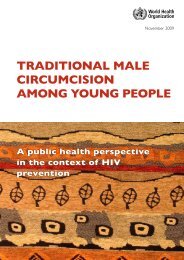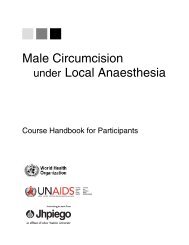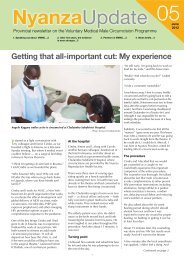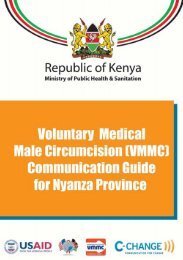Manual for Male Circumcision under Local Anaesthesia
Manual for Male Circumcision under Local Anaesthesia
Manual for Male Circumcision under Local Anaesthesia
You also want an ePaper? Increase the reach of your titles
YUMPU automatically turns print PDFs into web optimized ePapers that Google loves.
<strong>Male</strong> circumcision <strong>under</strong> local anaesthesia Version 2.5C (Jan08)<br />
Active listening<br />
Active listening involves paying attention to what a client says and<br />
does, in a way that shows respect, interest and empathy. Active<br />
listening is more than just hearing what clients say. It is paying<br />
attention to the content of the message, as well as the client’s feelings<br />
and worries that show through his movements, tone of voice, facial<br />
expressions, and posture.<br />
Example:<br />
The client looks very nervous and is biting his nails, but tells the<br />
counsellor he is fine.<br />
Counsellor: “Sometimes when we think we are relaxed, we can still<br />
feel quite anxious inside. I see you are biting your nails. Perhaps<br />
something is bothering you that you do not know how to express.<br />
Do you have any idea what that might be?”<br />
Open questioning<br />
Open questions are questions that require more than a one-word<br />
answer. They usually begin with words such as “how”, “what” or “why”.<br />
Open questions encourage clients to express their feelings and share<br />
in<strong>for</strong>mation about their situation.<br />
Examples:<br />
“Why have you decided to come <strong>for</strong> male circumcision?”<br />
“How do you think circumcision can reduce your risk of STI or HIV<br />
infection?”<br />
“What do you do that may make it possible <strong>for</strong> you to get infected<br />
with an STI or HIV?”<br />
“What are you currently doing to protect yourself against STIs and<br />
HIV? How is this working?”<br />
Probing<br />
Probing is using questions to help clients express themselves more<br />
clearly. Probing is necessary when the counsellor needs more<br />
in<strong>for</strong>mation about the client’s feelings or situation. Asking a probing<br />
question is a good way to follow up on a question that has been<br />
answered by “yes” or “no.”<br />
Examples:<br />
“Can you tell me more about that?”<br />
“How do you feel about that?”<br />
Educating and Counselling Clients and Obtaining In<strong>for</strong>med Consent Chapter 3-7<br />
<strong>Male</strong> circumcision <strong>under</strong> local anaesthesia Version 2.5C (Jan08)<br />
Focusing<br />
Clients are often overwhelmed by emotional or personal problems<br />
related to their particular sexual and reproductive health problems.<br />
They may want to address all the issues at once. If clients start to talk<br />
about problems or situations that will be discussed later in the session,<br />
the counsellor may want to bring the topic of discussion back to the<br />
current issue.<br />
Example:<br />
At the beginning of the first counselling session, the client begins<br />
talking about the most recent situation when he may have been<br />
exposed to HIV. He asks about where and how he can get<br />
condoms.<br />
The counsellor does not want to interrupt the flow of the<br />
discussion, so says: “Using condoms is an excellent way to reduce<br />
your risk of getting an STI or HIV infection. We can talk about that<br />
in a few minutes. Right now, let’s continue talking about your HIV<br />
situation.”<br />
If the client wants to talk about other emotional or personal issues,<br />
such as problems at home or a partner’s drug use problem, the<br />
counsellor should help the client find appropriate support.<br />
Affirming<br />
Affirming is congratulating or complimenting clients on the positive<br />
actions that they have taken. It is important to encourage success.<br />
Complimenting clients helps them feel respected and valued and<br />
encourages them to try to make other changes to reduce their risk of<br />
HIV infection. It may also make them more willing to share in<strong>for</strong>mation<br />
about other actions they have taken.<br />
Example:<br />
Client: “I’ve recently started using condoms each time I have sex”.<br />
Counsellor: “That’s a really positive step in protecting yourself<br />
against HIV and sexually transmitted infections. Well done!”<br />
Clarifying<br />
Counsellors clarify in order to make sure that they <strong>under</strong>stand a<br />
client’s statements or questions. Clarifying also helps the client<br />
<strong>under</strong>stand his own situation or feelings better and identify uncertainty<br />
or conflict between his thoughts and behaviour.<br />
Example:<br />
Client: “My partner gave me gonorrhoea. I’m afraid of getting HIV.<br />
But I’m also afraid that, if I use condoms when I have sex with her,<br />
she’ll think I am not faithful.”<br />
Educating and Counselling Clients and Obtaining In<strong>for</strong>med Consent Chapter 3-8












